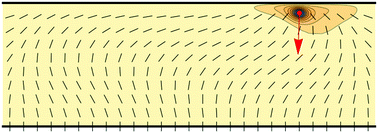Theory of defect motion in 2D passive and active nematic liquid crystals
Abstract
The motion of topological defects is an important feature of the dynamics of all liquid crystals, and is especially conspicuous in active liquid crystals. Understanding defect motion is a challenging theoretical problem, because the dynamics of orientational order is coupled with backflow of the fluid, and because a liquid crystal has several distinct viscosity coefficients. Here, we suggest a coarse-grained, variational approach, which describes the motion of defects as effective “particles”. For passive liquid crystals, the theory shows how the drag depends on defect orientation, and shows the coupling between translational and rotational motion. For active liquid crystals, the theory provides an alternative way to describe motion induced by the activity coefficient.



 Please wait while we load your content...
Please wait while we load your content...
